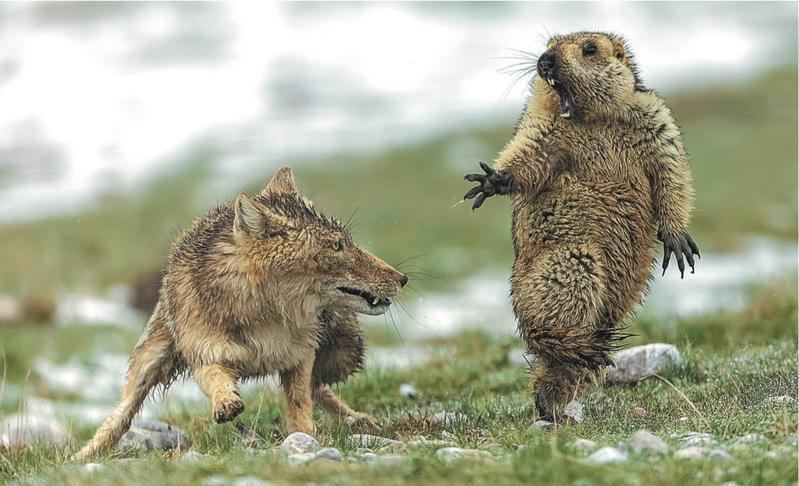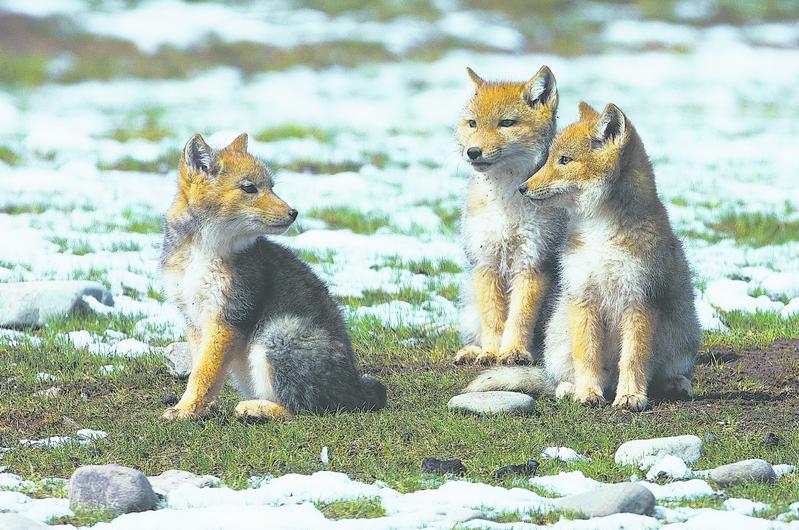 The Moment, the award-winning image that earns Bao the Wildlife Photographer of the Year 2019 award. (PHOTO BY BAO YONGQING / PROVIDED TO CHINA DAILY)
The Moment, the award-winning image that earns Bao the Wildlife Photographer of the Year 2019 award. (PHOTO BY BAO YONGQING / PROVIDED TO CHINA DAILY)
A nature photographer's award-winning image captures an instant in time and international attention.
The Tibetan fox had lurked for an hour before the Himalayan marmot left its burrow on a snowy afternoon on the Qinghai-Tibet Plateau in June 2018.The canine leapt. The rodent's jaws opened in terror.
The moment was frozen in time-as a photograph.
Bao Yongqing had also been lurking nearby. And the image he captured, titled The Moment, earned the Grand Title Winner prize and won Bao the Wildlife Photographer of the Year 2019 award. The Qinghai province native accepted the honors at the Natural History Museum in London.
At a time when precious habitats are facing increasing climate pressures, seeing these fleeting yet fascinating moments reminds us of what we need to protect
Michael Dixon, director of London Natural History Museum
He also shared the award for Best Picture in the Mammal Behavior Category.
Bao's photo is among 100 on display at the London museum until May 31.
"At a time when precious habitats are facing increasing climate pressures, seeing these fleeting yet fascinating moments reminds us of what we need to protect," museum director Michael Dixon says.
Judging panel chair Roz Cox says: "Photographically, it is quite simply the perfect moment. The expressive intensity of the postures holds you transfixed, and the thread of energy between the raised paws seems to hold the protagonists in perfect balance.
"To have captured such a powerful interaction between a Tibetan fox and a marmot-two species key to the ecology of this high-grassland region-is extraordinary."
Bao is the first Chinese photographer to receive the grand award in its 55-year history. The 52-year-old ethnic Tibetan is the director and chief ecological photographer of the Qilian Mountains Nature Conservation Association of China.
Bao started photographing wildlife nine years ago, when he guided some nature-photographer friends. They saw many animals. He thought about making an album of the nature in his hometown.
"I encountered many wild creatures as a kid," he says.
"I hope to leave a book with photos of my hometown's wildlife so that younger generations can learn what we have."
The Qilian Mountains are an important area for wildlife, including snow leopards, black-necked cranes and white-lipped deer. The Tibetan fox and the Himalayan marmot are unique to the Qinghai-Tibet Plateau.
The foxes breed from March to July. The fox Bao shot was raising three cubs. She'd hunt every morning, especially for plateau pikas.
 Three Tibetan fox cubs. (PHOTO BY BAO YONGQING / PROVIDED TO CHINA DAILY)
Three Tibetan fox cubs. (PHOTO BY BAO YONGQING / PROVIDED TO CHINA DAILY)
"There are lots of pikas, but they're hard to catch. If a Tibetan fox gets a Himalayan marmot, she can feed her young for two days," Bao says.
Bao knows the foxes' habits. The year he snapped the photo of the mother was his second year monitoring her. He'd found her den a year before and shot a video of her stalking a marmot.
The day he took the award-winning photo, he stayed a kilometer away from a marmot's burrow. He saw the fox slink downhill near the rodent's hole. He chose his angle and waited.
Bao says that Himalayan marmots are wary. The one in his photo had actually seen the fox and called out to warn others. But more than an hour later, it seemed to forget about the predator and re-emerged from its burrow to find food.
ALSO READ: Milu bounce back from brink of extinction
"The Tibetan fox saw her opportunity and pounced. She suddenly attacked when she was 5 meters from the marmot and injured it," Bao recalls.
"Himalayan marmots are social animals. So, two other marmots saw their companion was in danger and came to repel the fox, which ran between the three rodents, looking for a chance to attack the injured marmot.
"The wounded animal lost consciousness a couple of minutes later. The fox grabbed it and left.
"I was conflicted about the potential results when I saw the fox was going to attack. The perfect ending would have been both of them still alive after a fight. I could shoot the battle, and they'd both leave safely."
The pictures following Bao's award-winning shot are grisly.
"That's nature," he says.
 Red deer are endemic to the Qinghai-Tibet Plateau. (PHOTO BY BAO YONGQING / PROVIDED TO CHINA DAILY)
Red deer are endemic to the Qinghai-Tibet Plateau. (PHOTO BY BAO YONGQING / PROVIDED TO CHINA DAILY)
He took thousands of photos over three hours that day.
But the gruesomeness of the images meant he didn't review them until a week later.
Bao realized while speaking with the nature photographers attending the awards ceremony that they had limited knowledge about China's wildlife. He showed them several images he shot with his phone.
"They were surprised by the diversity of the Qinghai-Tibet Plateau's wildlife. They'd never seen some of the animals. They'd like to visit."
Bao's award-winning image went viral online. Netizens edited it into memes featuring dialogues between the two creatures.
The photographer is impressed by netizens' creativity. He's happy that the memes enable more people to know about these animals.
He himself knows a great deal about the area's wildlife.
"Snow leopards are difficult to spot. It becomes a bit easier if you know where they breed and hunt," he says.
Bao would use an infrared camera to record creatures' activities and study their habits.
He'd then find a good spot to wait for hours or even days.
"I bring some simple food, water and a sleeping bag. Sometimes, I'll visit herders' homes for meals and then return to my spot."
He keeps a distance from the animals. If they seem comfortable with his presence, he'll move closer.
"They're smart. They notice you. But they get used to you soon if they believe you're not a threat."
He sometimes hides in holes, and uses grass and branches for camouflage.
Bao's goal is to record the lives of every species on the Qinghai-Tibet Plateau, including mating and feeding.
READ MORE: Wildlife protection efforts reach a fresh peak
"You can learn things from animals, like patience. A snow leopard can remain perfectly still for a whole day while hunting. But we humans lack such patience."
He believes wildlife photography's purpose is to present pristine nature.
"I've come to realize there's still much to be done for environmental protection," he says.
"I believe it's my responsibility to show people that wild animals are humans' indispensable friends."


